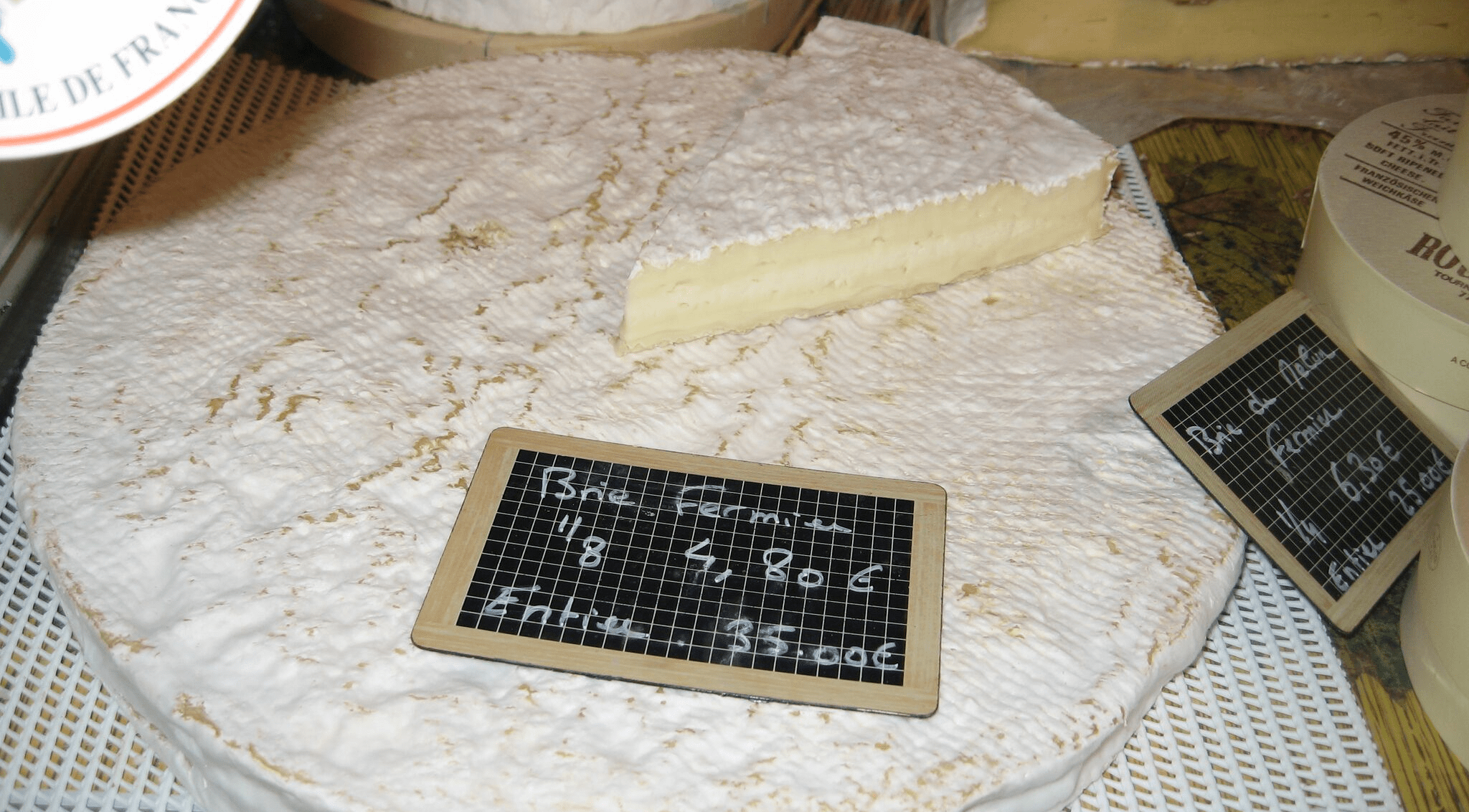What is Brie de Meaux AOP?
Brie de Meaux AOP is one of the great cheeses of Europe, one of cheese’s nobility. With its cousin Camembert from more rural Normandy, it is probably France’s most famous cheese export, defining French cheese for many people. Classic Meaux brie is 3kg white mould-ripened cheese, about 36-37cm in diameter and 2.5-3.5cm tall, like a flat disc. It comes from Meaux, 50km or so East of Paris. It is one of three eastern Paris Bries (the only PFN Bries in the world), the other two being Brie de Melun AOP and Brie de Nangis. Neither of these is familiar in the UK, making “proper Brie” meaning Brie de Meaux to most people. Meaux is the benchmark. So what is it and why buy it?
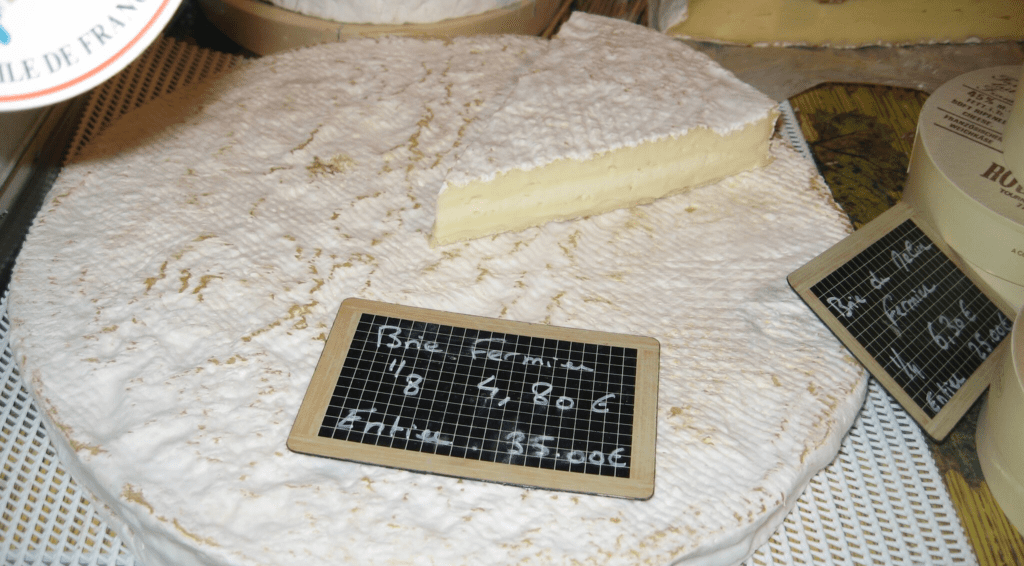
Why have Brie de Meaux AOP on your table?
Here are six good reasons:
- It’s was crowned “King of Cheeses” at the Vienna Congress of 1815! It is on the throne when it comes to mould-ripened cheeses.
- You must have something gooey on your cheeseboard. Even if it’s not Brie de Meaux, and there are many alternatives, you must have a mould-ripened cheese of some kind
- Your friends will know it
- Unlike Camembert, you can get the size you want
- It is affordable – some of the best producers are within range
- You can mature until its gooey as you like
- If (IF!) there is any leftover it makes great sandwiches
Where does the name come from?
Brie is an old name for a region to the east of Paris (part Ile de France, part Marne, part Aisne). Meaux being a town within the region. So brie, like Cheshire, is a cheese named for its country of origin, and Brie de Meaux is geography squared. Like saying Cheshire de Nantwich.
Brie dates back at least 1150 years, making it one of the oldest cheeses in Europe.
The history of Brie de Meaux and Brie de Melun is quite difficult to entangle, and it is likely when historically brie is referred to it may be either or both. What is the difference? Brie de Meaux is a rennet set making it chalky-curdy when unripe; Brie de Melun is a lactic set, making it chalky-pasty inside like an unripe Époisses. They none-the-less are sister cheeses, Meaux being the more famous. The below is taken from the Brie website https://www.briedemeauxetdemelun.fr/page/LHistoire-des-Bries/81 amongst others.
- 774 Charlemagne says Brie: “I just discovered one of the most delicious dishes that are” after enjoying a superb portion of Brie de Meaux at the abbey of Rueil-en-brie.
- 999 Robert II the Pious appreciates so much the Brie de Meaux that it ensures in person his trade.
- 1200 Brie becomes a political weapon: Blanche de Navarre uses it to flatter the greed of King Philip Augustus and get him the regency of the county of Champagne.
- 1534 Rabelais quotes Brie in his Gargantua
- 1600 Queen Margot makes slices of Brie to Henry IV who is very fond of it to prevent him from going to join his beautiful mistress, Gabrielle d’Estrées.
- 1668 La Fontaine puts a Brie in the beak of the raven, to the great spite of the fox of the fable.
- 1710 Louis XIV loves Brie and wants it every day on the menu. 50 cars commute Versailles-Meaux to supply weekly the King’s table.
- 1725 Louis XV marries Marie Leczinska, the gourmet queen who invented Brie “Bites à la Reine”, a kind of canape.
- 1791 Louis XVI “allegedly” gets captured fleeing Paris for stopping for a brie sandwich. Or he is said to have requested a final taste of Brie de Meaux before his arrest. It’s a bit hazy.
- 1793 The revolutionary Lavallée noted that “the cheese of Brie, loved by rich and poor, was preaching equality before it was ever imagined to be possible”.
- 1815 Thanks to Talleyrand, a great diplomat and gourmet, the brie is crowned “King of Cheeses” at the Vienna Congress!
- 1980 AOC status granted (seems quite late!)
Basically this is one the greatest and longest-lived cheeses, with a royal and splendid history. It appears there are many small and large makers to enjoy the fruits of.
Is there more than one type of Brie de Meaux AOP?
No.
As above the Melun brie is distinctly different, and Brie de Meaux is very much not a generic “brie”. The word “brie” has no control over its use, and is now found worldwide. A more full look at the alternatives are in the Alternatives section below
Here are the only two Brie de Meauxs I am aware of:
- Brie de Meaux The classic as outlined by the PDO certification
- Black brie This is an ageing process that makes (any) brie hard and the colour of caramel. You can occasionally find black Brie de Meaux.
What does Brie de Meaux look like?
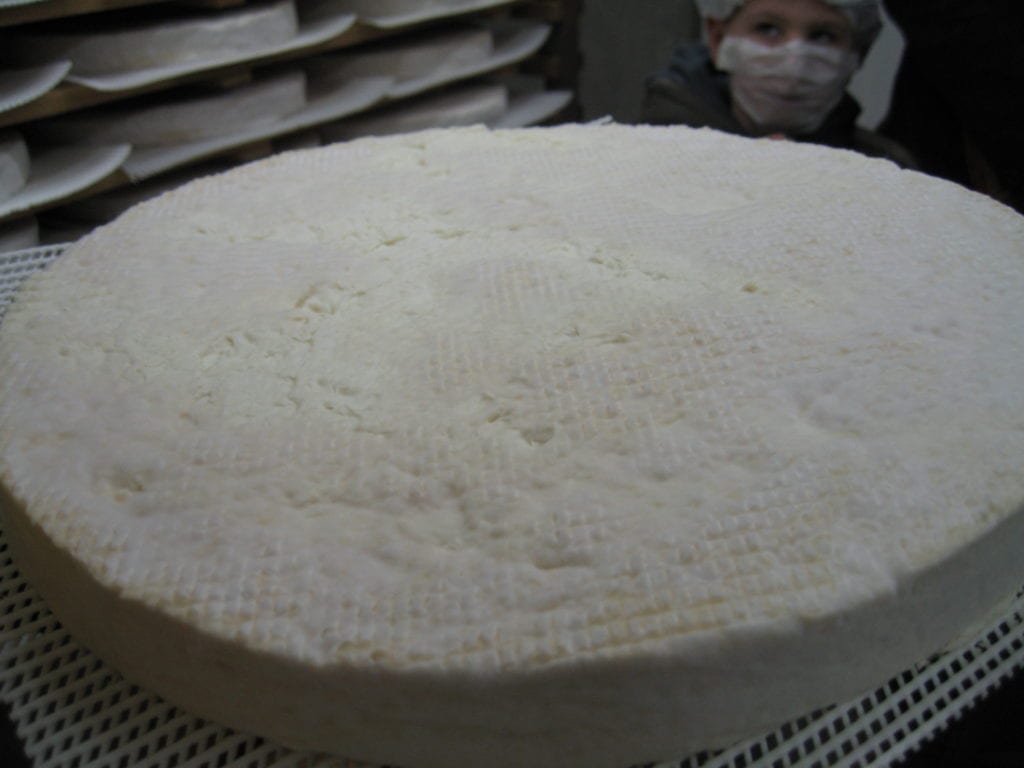


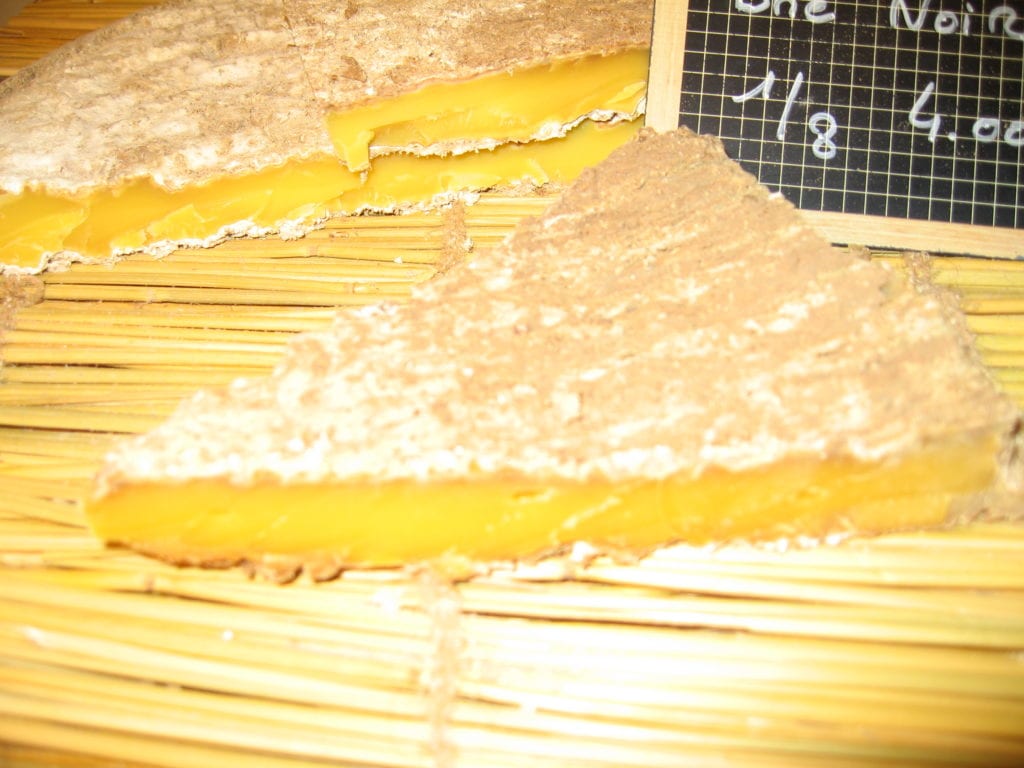

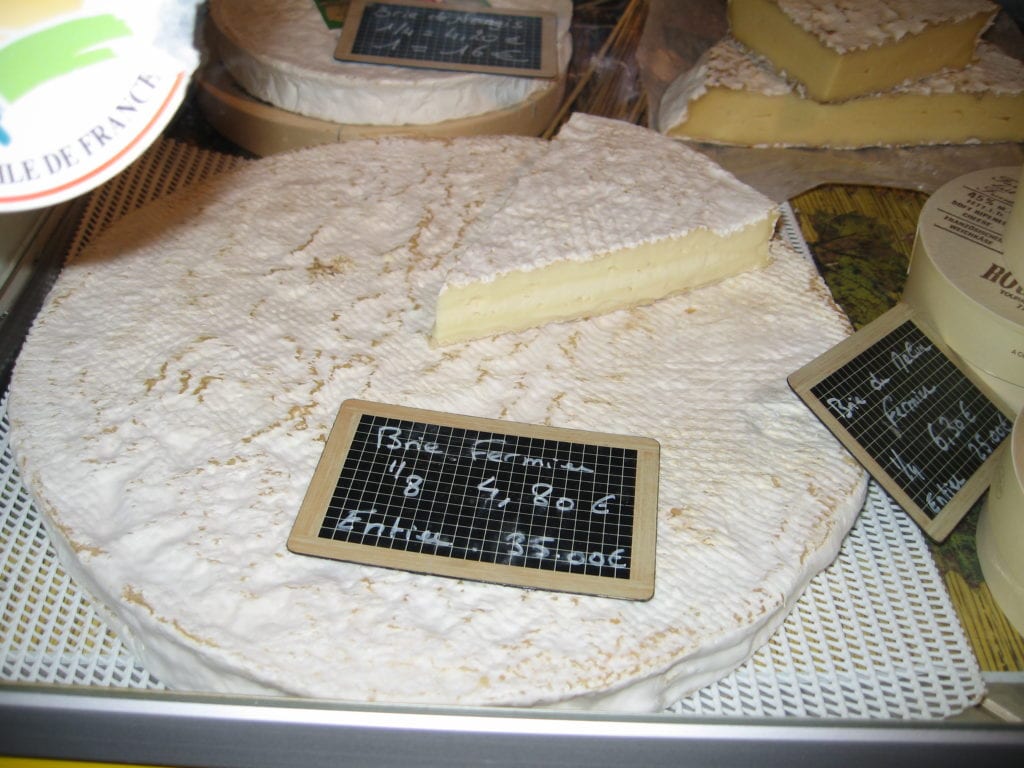
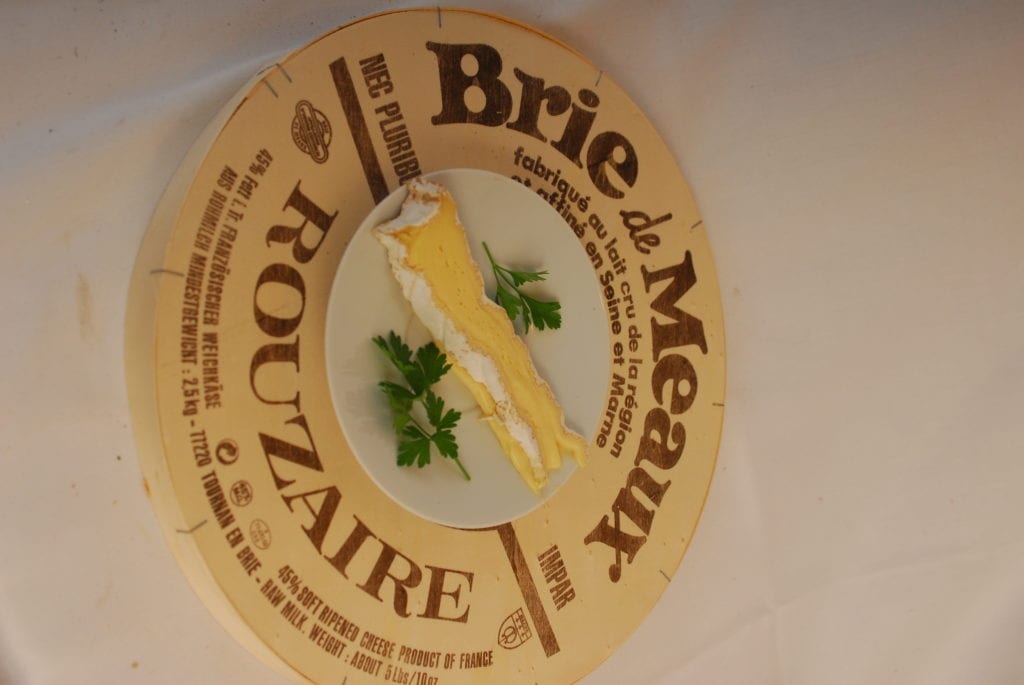
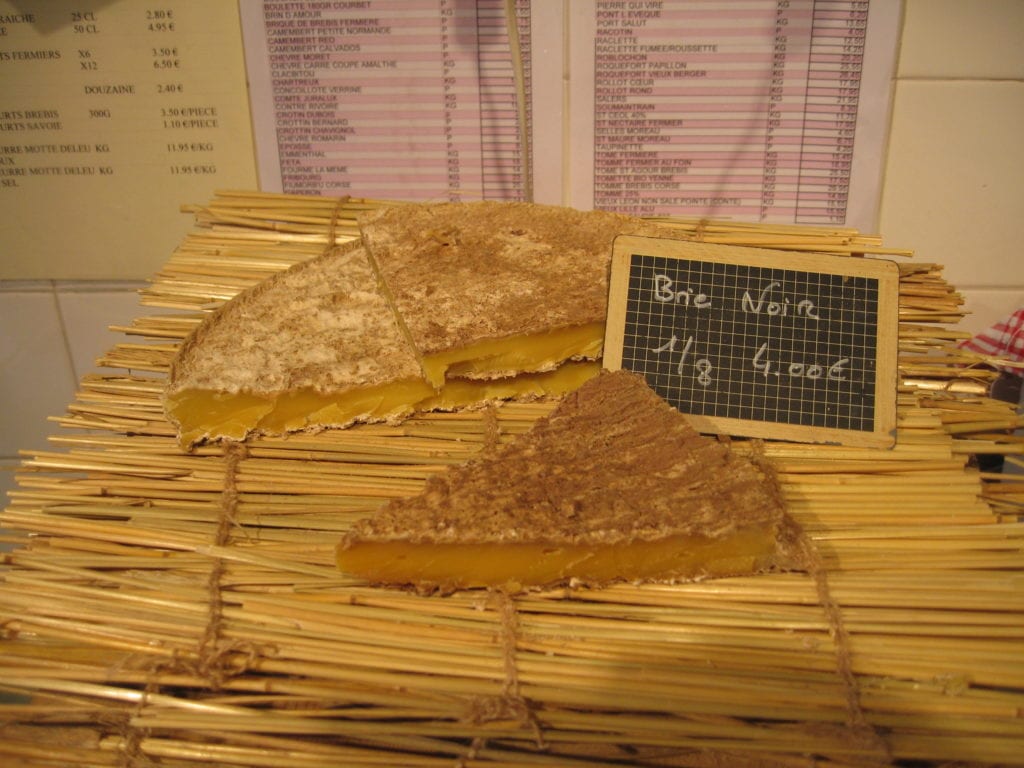
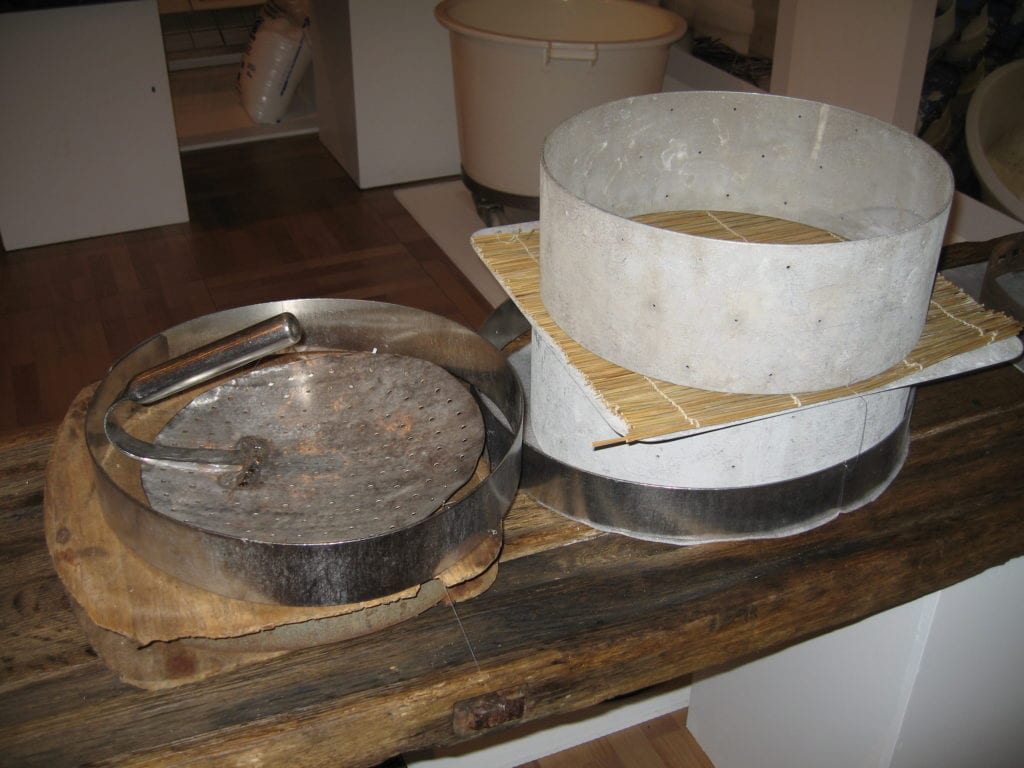
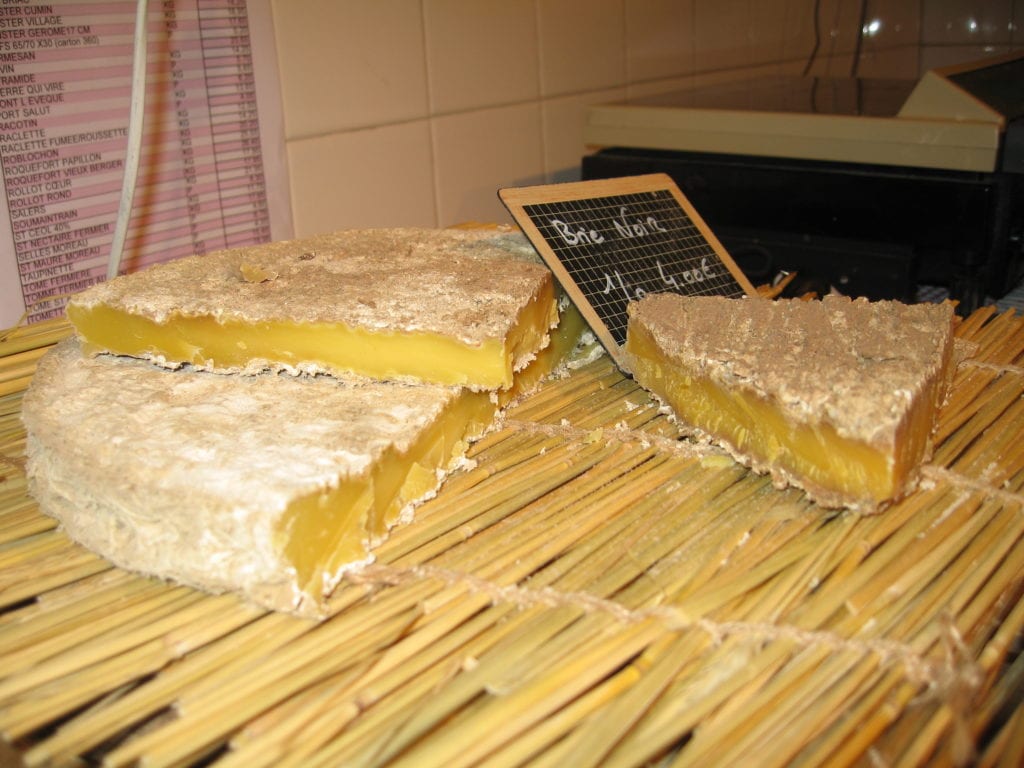
Shape
- A disc, 36-37cm in diameter and 2.5-3.5cm
Rind
- White mould, p. Camemberti dominant.
Should you eat the rind?
Yes, but the outer edge matures fastest, so you may choose to leave that bit if it’s over the top.
Paste
The paste of a cheese can be experienced in three main stages:
- Pre-ripened The paste is chalky and dry. The rind is bright white – Needs further maturation
- Ripening The paste is still chalky in the middle, but the under-rind paste has become elastic and gooey. The rind is mostly white, with grey flecks on the risen areas. – Needs further maturation
- Ripe The centre of the cheese is slightly holey and firm, but has become elastic in texture (not chalky). The paste under the rind is gooey and becoming slightly runny. The rind is matt/dull white, the colour of button mushroom. Ideally red or orange flecks are appearing. While this doesn’t always happen it is an excellent sign. The outer edge may smell of ammonia. – Ready to go.
- Just over ripe The centre of the cheese is gooey; and/or The top and bottom rind is smelling of ammonia – Only for harder souls.
- Overripe The centre of the cheese is running away; and/or The rind is one or more of: – Wet – Breaking up and lifting – Grey – Splitting – Smelling badly of ammonia – It is too late for this cheese. You can’t even cook with it.
What does Brie de Meaux taste like?
Using the tasting notes:
- Paste applies to the body of the cheese
- Numbers range from 0-10, 10 being highest, 0 being not present
- Cheese can vary significantly in some areas, and number can vary. If you have anything you would like to add drop me a message
Before you taste the cheese…
| Texture/consistency | Paste | Rind | Comments |
| Texture | Soft: 3 | Medium: 4 | Un-ripened curd will be firmer: 5 |
| Consistency | Elastic and gooey, small holes towards the centre | Carpet like | |
| Blueing | None | None |
| Smell | Stronger as it matures. A light button mushroom when young, maturing to a nasal , woodland sometimes earthy mould, then ammonia when older. Mid-range 5/10 when perfectly ripe. Ammonia on the edge is acceptable, but when the top and bottom smell of ammonia, the cheese has become over-ripe at least on the surface |
When tasting the cheese
| Mouthfeel | Paste | Rind | Comments |
| Texture | 3/10 for ripened paste, 4/10 for chalky paste. Brie has a warm creamy texture, almost like it has been cooked. | 5/10: disappears quickly into the cheese when young or ripe. As the cheese gets older the rind becomes cloth like in the mouth and bitty in the teeth. | Texture can be very temperature dependent |
| Wet to dry | 5-4: neutral to wet | Lightly drying |
| Simple flavours | Paste | Rind | Comments |
| Savoury | Vegetal: 3-7 | Not noticeable | |
| Sweet | Creamy: 3-6 | Not noticeable | The overall simple flavours are of a savour sweet creaminess |
| Salt | Mid: 4-5 | Not noticeable | |
| Bitter | Low: 0-2 | Variable, depending on make, age and quality | Rinds can add significant bitter notes in bries, though more rarely in Brie de Meaux. |
| Acid | Low: 1-2 | Not noticeable | Occasional tang in the end flavours |
| Complex Flavours | Likely | Occasional | Rare |
| Dairy | Cream 6-7; cream cheese 5 | Butter 1-2; Lactic 1-2 | |
| Fruity or Floral | “Nutty” (1) | Almonds 1-3 | Hedgerow flowers 1-2 |
| Vegetal or herbaceous | Wet leaves, forest floor 1-3 | Wet straw 1-4; Cabbage, cauliflower or leak 1-6 | |
| Mineral or chemical | – | Under-ripe bries: chalk/chemical | – |
| Animal, fungal or fermented | Woodland mushroom 4-6 or Field mushroom 4-6; | Under-ripe bries: button mushroom 1-6; Over-ripe: fermented notes and nasal tones 0-10 | Musty, earthy or leaf mould 1-5; truffles 1-3 |
(1): Nutty is a common mis-tasting of when sweet and savoury are both high. It may be nutty, or just sweet and savoury. Ask yourself if you can identify a specific nut.
Overall assessment
| Complexity | This is a highly complex cheese at its best: 8-9 |
| Balance | 8 when ripe: Brie de Meaux is possibly the most consistently balanced of the mould ripened cheeses. |
| Length | At its best brie lingers in the mouth, but does not have the acidity to last for a long time: 6. |
| Summary | Brie de Meaux is a sweet savoury cheese, with strong creamy woodland flavours of mushroom and woodland, with occasional notes of nuts and allotment greens. At perfection, the cheese has a high degree of balance and complexity and an umami moreishness. Ripening is key: under ripe reduces all the flavours, and may introduce chemical or chalky notes with a slightly positive button mushroom; over ripe brings in fermented and nasal notes, plus bitter rinds and strong ammonia aromas. |
Who makes Brie de Meaux AOP and is there many variations in quality and flavour?
There are many producers, but two are the most common in the UK
- Rouzaire Slightly thinner than Donge, it is sharper and less creamy but better prone to becoming runny.
- Donge Thicker and creamier, with a slightly longer period when it is tasting at its peak
If you have suggestions of other alternatives please email me on charlie@turnbulls.co.uk, twitter @Turnbulls_ and Instagram @charlie_bigcheese. Please send pictures if you have them, no matter how bad!
Alternatives
- “Brie” Any cheese can be named brie, as the word (like cheddar) is completely uncontrolled by legislation. It has spread around the world.
- Petit Brie 1kg bries, but can’t be de Meaux
- Brie de Pays Like Vin de Pays, this is a French way of saying a country or farmhouse brie, not a “de Meaux”
- Brie de Melun Melun is another town in Brie and has its own brie style that has received an AOP. Rare in the UK.
- Brie de Nangis Nangis is another town in Brie, and has its own brie style, but it does not have a protected food name. Rare but occasionally encountered in the UK
- Coulommiers (sometimes Brie de Coulommiers) A small cousin, 340g or so, to Brie de Meaux, and very old in provenance. A PDO is being proposed.
- Somerset Brie Made by the Lubborn Creamery in Somerset now owned by the big French company Lactalis. Widely available in supermarkets, this cheese has improved significantly over the last few years, but remains heavily reliant on good finishing/ripening to get the flavour out.
- Baron Bigod A newish cheese and the closest we have to a raw milk French Brie. Made in Suffolk by Jonny & Dulcie Crickmore at Fenn Farm. (Ps their butter is truly awesome)
- Other British Bries British cheesemakers have realised they don’t really have to say the word brie in their name to get sales, customers can tell what it is from looking. Hence many are dropping “brie” form their brand and leaving that to the French.
Bries from other countries There are many.
A word on brie vs camembert
Like brie, camembert has no legal controls over its use (Camembert de Normandie has the PDO). What is the difference between brie and camembert? At a PDO level, there are lots of differences, but more widely, the differences in taste and texture fall away. The only thing that remains standing is size.
Bries are big, 1-3kgs, camembert are small, 150-300g.
How do you use Brie de Meaux AOP – and what should I pair it with?
Lunch, cooking or cheeseboard
All three, though cooking is limited.
- Lunch: Brie de Meaux AOP is a classic lunch cheese for salads, biscuits or sandwiches
- Cooking: where you are baking slices of brie can be excellent as a tasty and good looking top garnish, maybe added at the end. However brie is flawed for most cooking for three reasons:
- 1. Its taste is not great when cooked, it may become a bit nasal and/or metallic
- 2. The rind becomes bitty when stirred through any dish
- 3. At high heats brie can degrade into fatty oil
- Cheeseboard: get your ripening right and brie will be the star of the show. It suits red wine, the most common accompaniment to cheeseboards, it is luxurious and people love it.
Sweet or savoury tracklement: Jelly, pickle or chutney?
Brie de Meaux AOPs like sweet: jellies, fruit cheeses and more. Savoury chutneys and pickles are not so good. Whole dried fruits like sun dried figs or tomatoes are excellent.
Wines, beers and other drinks
- White wine: Dessert wines have more success than other whites, although champagne works very well.
- Red wines: Bordeaux is said to the classic, although fruity Burgundies are my favourite.
- Bitters: Generally no. Craft bitters always break the rules so there maybe one or two that will work.
- Lagers: No
- Juices: Some berry cordials are very good with brie.
- Ports: Ports of all stripes go well with Brie de Meaux
- Others: Still looking
Caring for Brie de Meaux AOP in the home
Bries are mould ripened cheese which means the outer white coat is a mould, predominantly for brie penicillium Camemberti. It is a white downy mould that when young looks and smells like button mushrooms.
The mould releases enzymes into the paste, and the enzymes breakdown the paste from being chalky to being gooey. It can do this up to about 10-15mm. As the mould is on the outside, it ripens from the outside to the inside, so just inside the edge rind will ripen first, and the very centre of the cheese will ripen last. In the right circumstances, p. Camemberti can fully ripen a cheese no more than 3cm thick, maybe 3.5cm with clever affinage. (Other moulds and yeast perform differently.)
The Environmental rules for brie are that you can leave it out of the fridge for 2 hours, and then return it to the fridge for normal use. You can leave it out of the fridge between 2 and 4 hours, and then it must be consumed or disposed of.
This is very limiting, and most ordinary people are either not aware of the rules or ignore them. Many of my customers over the years leave cheeses out, especially bries and camemberts to ripen them. As a professional, I CAN NOT advise people to do this.
I can say that in my own home I try to find the coolest place in the house to do my final ripening. I am allowed to poison myself.
Larders are best if you have one, with stone, marble or slate shelves, but these are rare now. Some of my customers use their garages, unheated spare rooms, utility rooms or porches. They are trying to represent the producers maturing rooms, which means between 10 and 16oC for final ripening. Above 20oC and you will over ripen on the outside of the cheese and bring on a smelly rind while possibly still having a chalky centre. Kitchens are NOT good. Today’s kitchens are 21-24oC in temperature, which is too hot for ripening. These customers say 1-2 days is generally plenty. I am told they then put them back in the fridge to slow down the process again until they want to eat it.
Storage
- Number 1 choice – In your fridge: I use a Tupperware, and am quite happy putting all my cheeses together, unwrapped and even touching when I have a lot of cheeses in the house. The exception is the washed rind cheeses. These don’t play well with others and should have their own box.
Why doesn’t the white or blue mould get into other cheeses? Given enough time it will, but you’ve got a week. just keep eating your cheese at a good rate
- Number 2 choice – Clingfilm: it really works, keeps the air out and is less harmful on the environment than bagging them up
Storage DONTs
- I don’t like greaseproof paper. It is generally not recyclable nor proof from cheese drying out, and once used two or three times becomes dirty and a hazard. I agree it looks cool, but cheese looks best naked anyway.
- Tinfoil: some blue cheeses use it but it is not the same as the stuff you buy in supermarkets. It has a plastic coating on the cheese side. Don’t use your own.
Consumption
Bring to room temperature before consuming, this means 20-23oC in most houses. An hour should be plenty for wedges, for large pieces leave a little longer.
Charlie’s top tips: How to buy a good piece of Brie de Meaux AOP
Here are my two golden rules:
- Always taste before you buy (if you can)
All cheeses are affected by their whole journey, not just who made them. The season of making, the weather on the day, who by and how they were matured, how long they will in the chill chain (chilled transport system) for. - Buy your wedge cut off from a big cheese (if you can)
All cheeses like to stay whole as long as possible. Pre-pack is never as good, head to the deli counter.
For brie, therefore, take these rules together and you see you need to buy your brie as close to when you want to eat it as possible. A small wedge may not ripen once away from its cheesey mothership.
Equally and for the same reasons, I try never ever to buy prepack. It’s a lottery, most prepack brie is dead cheese, and if it is not in the condition you want it when you buy it never will be. If you have to have pre-pack, go for whole camembert over brie. It’s built for it.
Is it suitable for pregnant and immunity fragile people? NO: the is cheese is not within NHS guidelines https://www.nhs.uk/conditions/pregnancy-and-baby/foods-to-avoid-pregnant/

